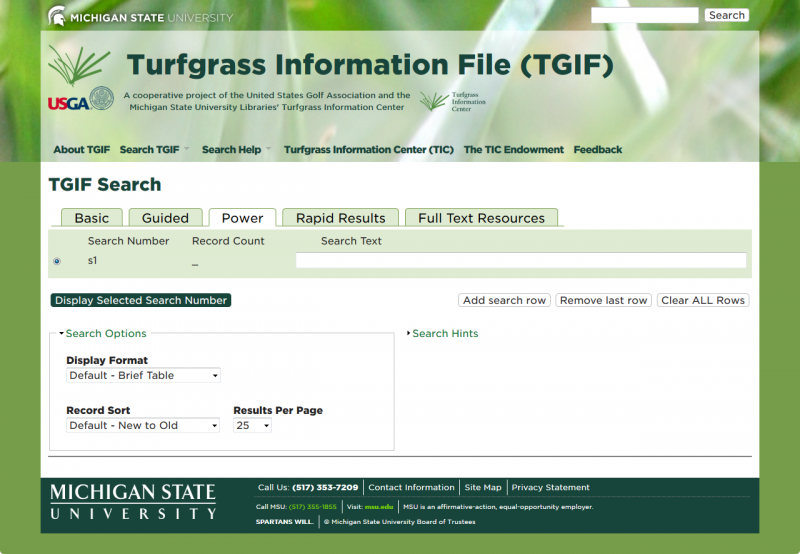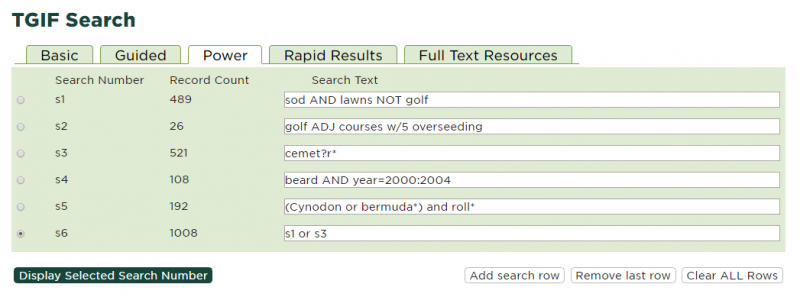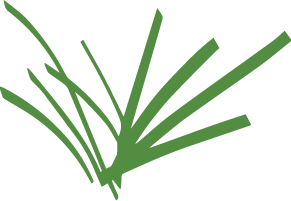Power Search Help
The "Power Search" interface in the Turfgrass Information File (TGIF) database provides an 'advanced search' alternative for experienced TGIF users. In it, you can use full Boolean and proximity operators, wildcards, nesting, field limiters,etc. For newer users of TGIF, Basic Search or Guided Search is recommended. To begin searching, enter a desired search term into the "Search Text" box and clicking "Display Selected Search Number". A powerful TGIF search can be built by utilizing the "Add Search Row" button along with the operators and wild cards described below.

- Common Search Fields in TGIF
- Operators Available in TGIF
- Wildcards (Truncation)
- Structuring Searches
- Null Values Searches
- Searching Reserved Words and Characters
- Default Boolean execution order
- Display Formats
- Using Power Search to Limit Searching to Selected Journals
- Search for Theses and Dissertations
- Power Search Examples
1. Common Search Fields in "Power" TGIF
Specifying a search field restricts the search to that particular data element(s) only. Once you have made a field specification on your search line, it is "in force" (i.e. the default) until you use another field specification. The "starting" default is [none] below, so you do not have to specify a field to start. To reset back to [none] in the middle of the search use "BI=xxxx."
- [none] Keyword, title, abstract, note, special limiter, etc. word
- eg.: FERTIGATION [same thing as: BI = FERTIGATION (This is the default search!)]
- R = TGIF Record number
- eg.: R = 1475
- T = Title word
- eg.: T = PYTHIUM
- TIF = Exact title match (as a string)
- eg.: TIF = TAKING SPIKELESS SHOES PUBLIC
- K = Assigned Keyword from the Turfgrass Thesaurus (as a string)
- eg.: K = POA ANNUA
- TK = Title or assigned Keyword word
- eg.: TK = SPIKING
- SUB = Title, assigned keyword or abstract word
- eg.: SUB = CALLUS [SUB = (CALLUS OR CALLI) would be even better]
- AB = Abstract word
- eg.: AB = DIMENSION
- LEVEL = Level of source (refereed, report, proceedings, professional, trade, popular, or newsletter) (more information on LEVEL)
- eg.: LEVEL = TRADE
- A = Authors, editors, etc.
- eg.: A = KARNOK [best to search as A = KARNOK, K*]
- AF = Author affiliation word
- eg.: AF = RUTGERS
- AUF = Author (field)
- eg.: AUF = Piper, C.V.
- BORA = Author or person-as-a-subject (i.e. for materials 'by or about' a person)
- eg.: BORA = HAMILTON [best to search as bora = HAMILTON,G*]
- NOTES = Note word
- eg.: NOTES = PICTURE*
- GMD = General Material Descriptor(see list)
- eg.: GMD = THESIS
- SCODE = Journal code (see list)
- eg.: SCODE = AGRON
- JO = Exact Journal name
- eg.: JO = FLORIDA ENTOMOLOGIST
- SO = Source (journal, book, website, etc.) word
- eg.: SO = TRENDS
- MEET = Meeting or Conference word
- eg.: CO = ORLANDO
- FAC = Facility name word
- eg.: FAC = MEDINAH
- FACF = Facility name field
- eg.: FACF = Almosta Golf Club | L Middlebury Wisconsin
- CV = Cultivar name
- eg.: CV = PENNCROSS
- CVF = Cultivar name as indentifier
- eg.: CVF = Hounddog V
- BUS = Business name word
- eg.: BUS = JACKLIN
- BUSF = Business name field
- eg.: BUSF = Oliphant Golf Construction Madison, Wisconsin
- WHO = Person as a subject
- eg.: WHO = NOER
- WHOF = Person's name as indentifer (field)
- eg.: WHOF = Piper, Charles VanCouver [but better to search as WHOF = Piper, C*]
- PUB = Publisher or place of publication word
- eg.: PUB = ARBOR
- YEAR = Year of publication
- eg.: YEAR = 1991
YEAR = 1994:2000 - DATE = Date of publication
- eg.: DATE = JANUARY [but better to search as DATE = JAN*]
- VOL = Volume number
- eg.: VOL = 47
- USGAP = USGA Publication
- eg.: USGAP = X
- ALL = all searchable fields (Use with caution! this can produce strange results!)
- eg.: ALL = sod
- TEXT = Full-text
- eg.: TEXT = Green AND Section
- SER = Article series title (word)
- eg.: SER = Chauncey
- SERF = Article series title (field)
- eg.: SERF = Dear Chauncey - Part II
- COL = Title of regular column in serial publication (word)
- eg.: COL = Soylet and Green
- COLF = Tile of regular column in serial publication (field)
- eg.: COLF = Soylent Green
- MONO = Monographic title (field)
- eg.: MONO = Weeds of the Northeast
- STI = Monographic series title (word)
- eg.: STI = Weeds and Sunshine
- STIF = Monographic series title (field)
- eg.: STIF = Weeds in the sunshine
- GEOW = Geographic term (state, region, country) as indentifer (word)
- eg.: GEOW = Dakota
- GEO = Geographic term (field)
- eg.: GEO = North Dakota
- LANG = Language
- eg.: LANG = Serbo-Croat
- S = , K = , DE = Descriptors (field)
- eg.: S = Achyranthes Repens
- DEW = Descriptors (word)
- eg.: DEW = Achyranthes and Repens
2. Operators Available in TGIF
"Operators"(Boolean operators) are used to combine, cross, or define the desired relationship between logical clusters.
- X AND Y Find records that contain both X AND Y
- eg.: TOPDRESSING AND SAND
- X ADJ Y Find records where these two terms occur adjacent to each other, in the specified order
- eg.: BOWLING ADJ GREEN*
- X OR Y Find records that are in either X OR in Y
- eg.: BERMUDA* OR CYNODON
- X NOT Y Leave out (of X) those things also in Y
- eg.: BLUEGRASS NOT BILLBUG
- X:Y Take everything between X and Y (inclusive)
- eg.: YEAR=1998:2000
- X W/ Y Find all records where these terms occur adjacent to each other, in either order
- X W/n Y Find all records where these terms occur within 'n' words, in either order
- X NEAR Y Find all records where these terms occur within 5 words, in either order
- X W/O Y Find all records where these terms occur within the same occurrence
- X W/S Y Find all records where these terms occur within the same sentence or subfield
- X W/P Y Find all records where these terms occur within the same paragraph
3. Wildcards (Truncation)
- * Multiple character, right hand
- eg.: RHIZOM*
- ? Single character, repeatable, right hand or internal
- eg.: FERTILI?ER
4. Structuring Searches (Nesting)
Up to 10 levels of parentheses may be used to structure logical clusters in compound, complex searches.
example 1: ((SALT* OR SALIN* OR NACL) AND (LEVEL=(REPORT OR REFEREED) OR GMD=(THESIS OR DISSERTATION)) AND YEAR=1994:1997) NOT SOLUTION
example 2: (((FAN OR FANS) AND AIR) OR (AIR ADJ (MOVE* OR FLOW))) NOT (FAN W/2(FLAT OR NOZZLE OR JET))
5. Null Values Searches
- To search the absence of data in a field, Search: xx=""
- where 'xx' is the search field specification
- Note: This is particularly useful in combination with the Operator NOT
- eg.: URL=NOT "" (ie.: The set of all records with URLs)
6. Searching Reserved Words and Characters
- Use "" to enclose a "reserved word" as a search word
- eg.: AF="OR" (as in Oregon)
7. Default Boolean execution order is:
NOT
AND
OR
(We suggest you use parentheses anyway to specify the intended sequence of execution...)
8. Display Formats
In TGIF/Web it is possible to change the display format and record sort of searched records. Once a search has been executed in the default setting, users may change the display format and sort from the drop-down lists at the top of the screen.
Display Formats:
- Default - Brief Table: tabular format with selected TGIF data
- Full Table: all fields in the TGIF record
- Display in Citation Format: display TGIF records in a Crop Science-like citation format
- Citation File Download
Sort Formats:
- Default - New to Old
- New to Old, Full-Text First
- Old to New
- 1st Author A to Z
- 1st Author Z to A
- Relevance
9. Information on Using Power Search to Limit Searching to Selected Journals
The SCODE ("serial code") for any journal is a simple, consistent abbreviation created by TIC to isolate a set of records from a specific journal or group of specific journals. Normally the SCODE follows through title changes, so it overcomes the complications of changing journal titles. (For example, both On Course and The Bull Sheet can be searched using the SCODE=BULLS).
Thus, SCODE=AGRON searches all articles which have appeared in Agronomy Journal. Alternatively, SCODE=(AGRON or CROPS) identifies articles which have appeared in either Agronomy Journal or Crop Science.
Normally, SCODE searches are used as a limited with another search term, eg.: A=Thossel and SCODE=NRLSE.
The TIC "Periodicals Monitored by TIC" page has links to tables that includes most of the SCODES in the TGIF database, but there are more than 3,700 titles which appear in the database! Please also remember that we selectively index most titles, with a very few exceptions (such as the USGA Green Section Record.) In other words, not all articles in Crop Science are listed in TGIF, rather only those judged to be potentially relevant to turf science, turf culture, or turf professionals.
Please also remember that we may not own a particular issue of any of the listed periodicals, or perhaps we have not yet processed it into TGIF (particularly for older materials).
You can help us acquire issues we may not have! Please see the Periodicals Monitored by TIC list to identify specific periodical SCODES.
10. How to Use Power Search to Find Theses and Dissertations
To determine if we already own a thesis/dissertation, search it as below in "Power Search" within TGIF, without the parenthesis or brackets:
A="authorsname" and GMD=[either "Thesis" or "Dissertation"]
e.g. A=Miltner AND GMD=Dissertation
When you display a record, it will say "Help us please - we need a copy of this item!" in the record if we need a copy.
11. Power Search Examples

In the search example above:
S1 demonstrates using Boolean operators
S2 demonstrates proximity searching
S3 demonstrates using wildcards
S4 demonstrates using both Boolean operators and ranged searching
S5 demonstrates parenthetical searching - note the search inside the parentheses occurs first
S6 demonstrates using prior Search Numbers in later searches
Other Notes & Searching for Specific Items:
- You can connect the various searches using the boolean operator AND.
- You can truncate using the asterisk (*). Example: DATE=NOV*. (This will find all NOVEMBER, NOVEMBER/DECEMBER, and NOVEMBER-whatever combinations. It is best to truncate as much as possible to increase the likelihood of finding the record.
- You can use ADJ to link two words, for example: TRANSITION* ADJ ZONE* will find the words "transition zone" in the field(s) you are searching, adjacent to each other.
- Using truncation (*)is often the key to finding articles.
- Title: Pick the oddest words in the title to search. For example, in The effect of construction profile and materials on the performance of greyhound tracks, type T=profile* and greyhound*. Then, display the records found and compare them to the citation. If you get a 0, try another combination of words (and exclude subtitle words.)
- Author: Search the title and author together like this: AUS=JOHNSON AND T=IMPACT*. For two or more authors, you can link them using AND. For example, AUS=(JOHNSON AND DUNCAN).
- Year: This is also handy to use in conjunction with another search term. For example:YEAR=2001 AND T=IMPACT*
- Date: Example: DATE=NOV* (always truncate DATE searching to an abbreviated form to find all variations and misspellings).
- Special Identifiers: SCODE and MCODE can be used to limit the search to a specific serial,or book.
Here are some examples: SCODE=GCMAN, for Golf Course Management, and MCODE=TARZT. SCODE search for serials, and MCODE search for monographs. Here is a list of commonly used SCODES. - Reprints: Since the turfgrass literature is heavily reprinted, particularly within the trade and newsletter publications, watch out for reprints. We try and cite the original source of publication for a work, but do not always have access to the original in order to do so.


